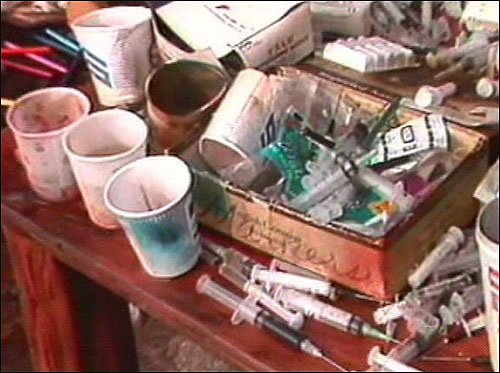A number of people who went into Jonestown following the deaths noted that an unknown number of bodies had puncture marks made by hypodermic needles, and even some bodies with the hypodermic still protruding from them. There were also numerous empty needle-less syringes scattered around in locations concentrated especially near the central distribution area for the cyanide poisoning.
 There is less debate about the needle-less syringes, even if the explanation is horrifying: according to several eyewitness accounts, including those of Odell Rhodes and Stanley Clayton at the official Guyana inquest into the deaths, the deaths began when parents stepped forward and used the syringes to squirt the fruit punch laced with cyanide down the throats of their babies. Practically all of the babies and many other smaller children likely died in this way.
There is less debate about the needle-less syringes, even if the explanation is horrifying: according to several eyewitness accounts, including those of Odell Rhodes and Stanley Clayton at the official Guyana inquest into the deaths, the deaths began when parents stepped forward and used the syringes to squirt the fruit punch laced with cyanide down the throats of their babies. Practically all of the babies and many other smaller children likely died in this way.
As for the syringes with the needles still attached, a number of theories as to their purpose have arisen, and the debate will likely never be resolved. There is not even a consensus on the number of bodies affected in this manner, most likely because the personnel responsible for removing the remains had many more pressing concerns than counting needles. In addition – and perhaps mercifully – there are no photographs that show the Jonestown dead in such detail as to show needles or puncture marks.
Nevertheless, Dr. Leslie Mootoo, Guyana’s chief pathologist, mentioned in numerous press accounts that a number of bodies had puncture marks, almost exclusively between the shoulder blades, which would imply that those bodies were of murder victims. His estimate of bodies so affected ranged from 70 to 180 to nearly 400, although since he apparently examined no more than 25 bodies, the numbers he raised have been called into question. Perhaps more importantly, when Dr. Mootoo testified before the same inquest as Clayton and Rhodes, he made no mention of needles or puncture marks.
Jonestown survivor Tim Carter is one of those who disputes Dr. Mootoo’s account in several particulars, although not the punctures themselves. In his article, Murder or Suicide: What I Saw, Carter describes “[t]he location of these injections [as] haphazard and varied [with] abscesses on a left temple, neck, back of hand, upper arm, lower leg, cheek, and back of shoulder.” Carter offers no conclusive number of his own on the number of bodies with injections but does state that the evidence leads to only one conclusion: “that the vast majority of those who died in Jonestown that day were murdered.”
There have been several conspiracy theories raised to explain the injection marks, including one that Carter mentions in his article, “that some outside force came into Jonestown and injected the bodies post-mortem in an attempt to make it look like murder.” He rejects that theory, and unless and until evidence appears to give credence to other hypotheses, history will likely disregard them as well.
There are two other non-conspiratorial explanations for some number of the puncture marks that should be considered, however. According to an article written by Washington Post reporters Charles Krause and Leonard Downie four days after the deaths:
The bodies, which had been on the ground for almost three days in the muggy climate here, were beginning to bloat. A Guyanese doctor was sent in yesterday to puncture them because it was feared many would burst open before today.
In fact, this did turn out to be the case, and the removal of the bodies became increasingly difficult as the week went on, because of decomposition and accompanying bloating and disintegration of the remains.
Finally, some marks were described by the pathologists at Dover Air Force Base working to identify the remains as common characteristics of the natural decomposition itself.